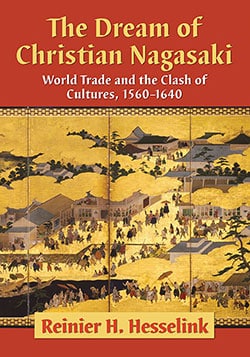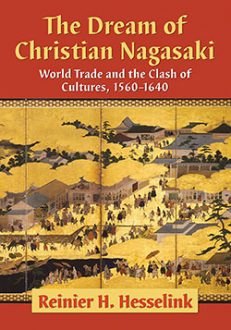The Dream of Christian Nagasaki
World Trade and the Clash of Cultures, 1560–1640
$49.95
In stock
About the Book
Nagasaki, on the west coast of the Japanese island of Kyushu, is known in the West for having been the target of an atomic bomb attack on August 9, 1945. Less well known is that the city was founded by Europeans, Jesuit missionaries who arrived in the area in the second half of the 16th century. The Jesuits had come to convert the Japanese. After baptizing a Japanese lord or daimyo of the area, they established Nagasaki in 1571 to provide the Portuguese a safe harbor in his domain. Profits for the daimyo and the Japanese who converted to Christianity soon followed.
This book is the first comprehensive history in any language of the rise and fall of Christian Nagasaki (1560–1640). The author provides a narrative of the city’s early years from both the European and Japanese perspectives.
About the Author(s)
Bibliographic Details
Reinier H. Hesselink
Format: softcover (7 x 10)
Pages: 300
Bibliographic Info: 4 photos, 3 maps, glossary, notes, bibliography, index
Copyright Date: 2016
pISBN: 978-0-7864-9961-8
eISBN: 978-1-4766-2474-7
Imprint: McFarland
Table of Contents
Table of Contents
Acknowledgments ix
Introduction 1
Abbreviated Genealogies of the Arima, Ōmura, Nagasaki and Chijiwa Houses 13
Timeline for the History of Christian Nagasaki 15
A Note on Currencies, Weights and Dates 18
Part One: Founding Fathers (1561–1586)
From Hirado to Yokoseura: Luis d’Almeida (1) 19
Becoming a Christian: Ōmura Sumitada (1) 21
The Mission’s Superior: Cosme de Torrès 29
A New Anchorage: Luis d’Almeida (2) 33
A Knight in Superior Armor: João Pereira 37
The Chinese in Nagasaki Bay: Nagasaki Sumikata 39
A Man for the Jesuits: Ōmura Sumitada (2) 43
Nagasaki Bay in 1568: Gaspar Vilela 46
The Busy Scribbler: Luís Fróis (1) 49
The Founding of Nagasaki: Francisco Cabral 52
No Place for the Fainthearted: Belchior de Figueiredo 57
Christian Champion: Gaspar Coelho (1) 62
The “Donation” of Nagasaki: Alessandro Valignano 64
The King-Sized Admiral: Ambrósio Fernandes 69
Militant Missionaries: Gaspar Coelho (2) 71
Part Two: Brave New World (1587–1613)
The Conqueror of Kyushu: Toyotomi Hideyoshi (1) 75
The Slave Trader: Domingos Monteiro 79
Rewriting History: Luís Fróis (2) 81
Master of the Tenka: Toyotomi Hideyoshi (2) 84
A Hapless Captain Major: Roque de Melo 89
A Spaniard from Peru: Juan de Solís 93
A New Head of the Mission: Pedro Gómez 99
The Spanish Spy: Bernardo Avila Girón (1) 102
A Cockaigne of Sex: Francesco Carletti (1) 106
The Martyred Mendicant: Pedro Blásquez 108
A Town Under Pressure: Francesco Carletti (2) 113
The Italian Painter: Giovanni Cola 117
A Chinese Madonna: Matsupo/Maso 122
The Eyes and Ears of Ieyasu: Ogasawara Ichi’an 127
Anti-Christian Cabal: The Hasegawa Siblings 133
The Last Conquistador: André Pessoa 137
Part Three: Forging a Yamato Soul (1614–1629)
The Second Prohibition: Tokugawa Ieyasu 144
The Last Processions: Bernardo Avila Girón (2) 147
The City Occupied: Yamaguchi Naotomo 152
The Destruction of the Churches: Hasegawa Sahyōe 157
An Early Apostate: Chijiwa Miguel 161
The Taiwan Expedition: Murayama Tōan 167
Dangerous Litigation: Murayama Tōan vs. Suetsugu Heizō 171
The New Governor: Hasegawa Gonroku (1) 174
In Pursuit of Ordination: Araki Thomé 180
Changes in the City: Hasegawa Gonroku (2) 185
The Summer of 1622: Bento Fernandes 188
A Japanese Padre: Kimura Sebastião 192
The Ten-Family System: Hama-no-machi Antonio 196
The Corral of the Martyrs: Sukedayu 201
Repressive Measures: Tokugawa Iemitsu 207
A Hard-Liner: Mizuno Morinobu 211
The Climax of the Persecution: Takenaka Shigeyoshi 215
The Brave Ex-Mayor: Machida João 217
Epilogue: Nagasaki in the 1630s 219
Glossary 227
Notes 229
Bibliography 260
Index 273
Book Reviews & Awards
“clearly the product of countless hours of painstaking historical investigation. The resultant study is nothing if not a model of thorough research…Hesselink’s book amounts virtually to a gazetteer of the early Catholic missions to Japan”—Journal of American-East Asian Relations.





